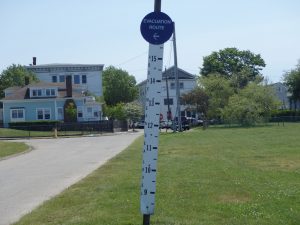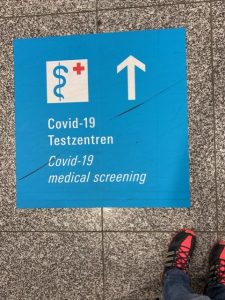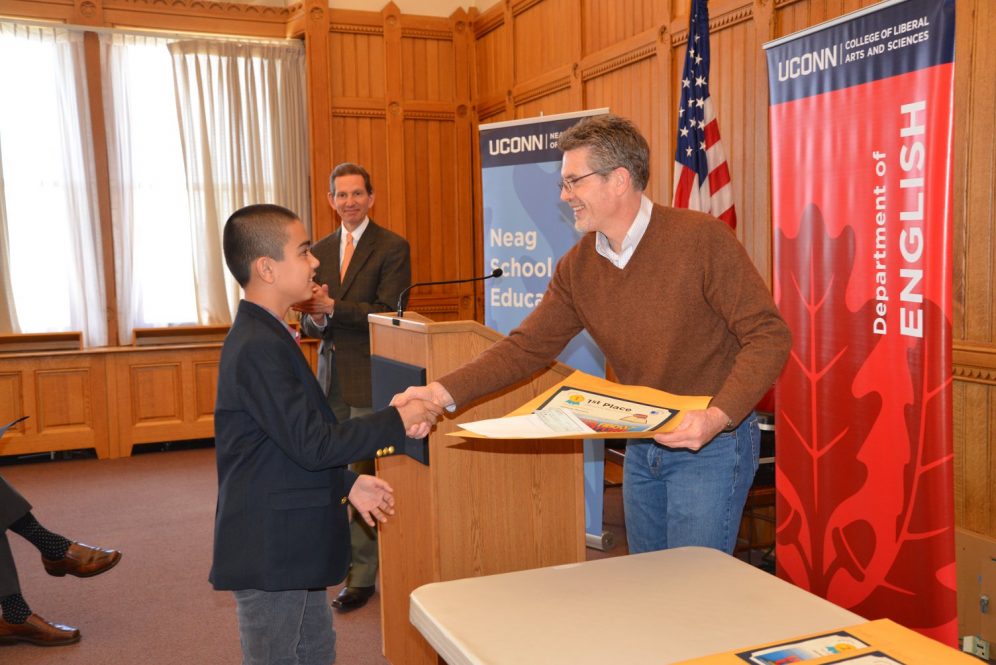Chadwick Schroeder ’20 (CLAS) did not know he wanted to work in the environmental field going into UConn. But in fall 2019, he enrolled in a newly-developed Climate Corps course, environmental studies 3100, Climate Resilience and Adaptation: Municipal Policy and Planning, and became excited to go to class.
In 2016, in response to rising sea levels, an interdisciplinary team of faculty at UConn launched Environmental Corps (E-Corps), a theory and practicum course series to teach students environmental literacy and assist municipal officials in adapting to climate change.
“You had to be in the environment, interacting with your peers like you would in a professional work environment, to produce results,” says Schroeder, who now works as Equity, Diversity, and Inclusion Intern for the Connecticut Chapter of the American Planning Association and a Program Assistant at Sustainable CT.
But the results won’t be immediate.
Across the College, students and faculty share the efforts they’re making today for results that will resonate at home and abroad for decades to come.
Climate Change in Connecticut
More than 300 students have participated in Climate Corps, Brownfield Corps, and Stormwater Corps, the classes that comprise E-Corps, so far.
This year, the faculty who created E-Corps received the Provost’s Community Engagement Award for engaging students in experiential learning and working with local communities to decrease disparities in environmental knowledge, resources, and effective disaster response planning.
In Connecticut, many town officials do not have up-to-date information on the types and number of polluted sites in their communities, Schroeder discovered during the class.
“One challenge is that each town has its own government structure,” says Carol Atkinson-Palombo, professor of geography, and a faculty advisor to E-Corps. “Some of the smaller towns don’t have the staffing to be able to understand what’s going on and think about solutions.”
For instance, Schroeder worked with the Naugatuck Valley Council of Governments to update the brownfields inventory for 170 sites. The Council manages the inventory for more than 15 towns. At the end of the class, he and his team submitted a cleanup grant for Stratford to the Environmental Protection Agency.
By helping municipalities inventory brownfield sites, which are often located next to low-income communities, Schroeder says, he helped them better understand spatially where they are and incentivize redevelopment to clean them up.
“By 2050, a lot of these sites will be inundated just by high tide,” Schroeder says. “When you model storm surge, that adds up to five feet more of water.”
Sarah Schechter ’21 (CLAS), who also took the Climate Corps course, worked with UConn Extension Extension Disaster Education Network and Connecticut Sea Grant, with a grant from the Rockfall Foundation, to produce films that educate municipal officials about the dangers of rising sea levels in Connecticut, legal issues, and ways to mitigate damage.
Schechter joined Climate Corps through a class with Juliana Barrett, an extension educator and founding researcher of E-Corps from the College of Agriculture, Health and Natural Resources.
“Knowledge is power and education is important,” Schechter says. “These climate issues will impact future generations. When they’re action-planning and making goals it’s important they think 10 to 15 years ahead.”
During the class, Schechter and Schroeder gathered historical maps of the coast, and data collected by the Connecticut Institute for Resilience and Climate Adaptation (CIRCA), to compare to current water levels. They could then demonstrate projections of sea level rise over the next 10 to 20 years.
Particularly, Schroeder found that brownfield sites, because they are older developments, were not built according to current flood planning needs and safety standards.
“In an old factory site along the Long Island Sound, for instance, storm water could pick up things like asbestos and pollutants you don’t want in the water,” says Schroeder.
In situations where people would need to evacuate or risk travelling through flood waters, as in New York City during Hurricane Sandy in 2012, it becomes more of a health hazard if the water is polluted, Atkinson-Palombo says.
“We are trying to ensure that municipal officials know how to plan for those issues, by increasing freeboard requirements when adapting strictures and placing them on stilts, and making sure evacuation plans are in place,” says Schechter.
“An important part of our work is stakeholder engagement,” says Atkinson-Palombo. “The more our students can get out and talk to municipalities and the general public, the more people get involved.”

Letters About Literature
For 28 years, hundreds of American students and teachers in Grades 4 through 12 have read a poem, book or speech and submitted essays to their favorite authors as part of Letters About Literature, a collaboration among UConn’s English Department, the Neag School of Education, and the Connecticut Writing Project.
This year, 645 students in schools across Connecticut wrote letters to authors on issues including racism, domestic abuse, and personal growth, and how the author’s work affected them personally.
Dozens of faculty, staff and students from UConn English and the Neag School volunteered to participate in scoring the essays and selecting finalists.
“One goal is to get the kids interested in reading, but a larger goal is to get them to enjoy writing in a way that interests the reader,” says Jason Courtmanche, assistant professor in residence of English and Director of the Connecticut Writing Project (CWP).
“The letters that end up making the semifinal round or winning are the letters that engage a discussion or take an original approach to addressing the author,” says Courtmanche. “They don’t follow a formula.”
In March, three winners were announced from among 96 semi-finalists. Amelia Athay from Essex Elementary School submitted a letter on The Trials of Apollo series by Rick Riordan; Wendy Guo from Mansfield Middle School discussed The Hate U Give by Angie Thomas; and Maxie Soja from Griswold High School submitted a letter discussing Speak by Laurie Halse Anderson.
The first-place awardees received a $100 reward, co-sponsored by Neag and the English Department.
Courtmanche says all participants gain a more creative approach to writing and communicating with their audience.
“Often students think of essays as not creative, yet there is a whole literary tradition of essays as a creative literary genre,” says Courtmanche.
Letters About Literature, along with the Scholastic Writing Awards, was run nationally through the Library of Congress’s Center for the Book for nearly 30 years. However, in 2019, the Library of Congress discontinued its administration of the contest. That’s when CWP stepped up to continue the state-level competition.
“The majority of winners of the Scholastic contest are in private schools,” Courtmanche says. “Whereas Letters About Literature has more diversity.” CWP tends to work more with public schools, and the teachers who encourage their students to submit letters are usually graduates of their Summer Institute.
“The teachers often come from the Neag School, either for their undergraduate or master’s degree,” Courtmanche says. “So it does tend to be public school teachers.”
Courtmanche and his team have directly reached out to public schools in cities like Hartford to get more diverse teachers and students involved.
“Whether we’re using Twitter or other social platforms, people write a ton more than they ever did,” Courtmanche says. “Seeing how we agree or disagree as a society, communication is profoundly important.”

Chronicling Our Experiences
Over the past year, the Pandemic Journaling Project has collected thousands of first-person narratives from individuals across the world to document their lived experiences during COVID-19 and elevate their voices in the annals of history.
In May, PJP Co-founders Sarah Willen, associate professor of anthropology, and Katherine Mason, assistant professor of anthropology at Brown University, co-organized a virtual public forum with the Connecticut State Legislature’s nonpartisan Commission on Women, Children, Seniors, Equity and Opportunity. Mark Overmyer-Velázquez, a professor of History and Latino and Latin American Studies at UConn and PJP advisory board member, was among the panelists.
“The Pandemic Journaling Project (PJP) creates an opportunity for policy makers to learn from the experiences of individuals who typically would not be there testifying and speaking into the historical record,” says Overmyer-Velázquez, who is also professor of History and Latino and Latin American Studies at UConn.
Journals have been collected weekly throughout the pandemic, and the PJP co-founders have created a research consortium to facilitate collaborative analysis in the near term. After 25 years all contributed materials will be deposited in a university archive as a public record for future historians and social scientists to examine.
So far PJP has collected a diversity of voices in written, visual, or spoken journal entries, with 20 percent participating in Spanish. Among the participants are essential workers, people from 45 countries, and immigrants.
“The typical voices in historical records are people with power and means,” says Overmyer-Velázquez. “Those were the people determining how the records were kept and how history is remembered.”
This is particularly problematic when historians look at the representation of “minoritized others,” Overmyer-Velázquez says, as it risks diminishing their lived experiences.
“Another nice feature of PJP is the bilingual nature of it,” says Overmyer-Velázquez. “More languages and multiple linguistic approaches will further expand the reach of it across the world.”
From the start, Willen, Overmyer-Velázquez, and the PJP collaborators set out to understand how everyday people’s lives will be represented when future historians look at the archives of the COVID-19 pandemic.
While speaking at the virtual forum, Overmyer-Velázquez, whose family migrated from Mexico to Chicago in 1950’s, recalled a similar archive that documented the experiences of thousands of Mexican migrants.
“During the Bracero Period, hundreds of thousands of Mexicans were recruited and encouraged to fill labor gaps in the United States,” he said. “We have all this rich treasure of migratory experience, but there was no way to capture that at the time.”
The Bracero History Archive now collects oral histories and records to provide a more complete picture of the twenty-year migratory work program between the United States and Mexico, to help inform current discussion about immigration policy.
“Like the PJP, there’s so much to learn from these voices and if they had not been captured, we would not have them,” says Overmyer-Velázquez.
These records are useful for writing formal academic histories. They will also enable scholars to produce a more theoretical and systemic way of thinking about this time period in history, and to humanize ideas about what caused the pandemic and how people experienced it.
“It creates a visceral sense of connection for people to have a broader sense of how they relate to humanity,” says Overmyer-Velázquez.
The E-Corps faculty team includes Chet Arnold, Mike Dietz, Dave Dickson, Juliana Barrett, and Bruce Hyde from the College of Agriculture, Health, and Natural Resources Extension’s Marisa Chrysochoou and Tim Vadas from the Department of Civil and Environmental Engineering; Todd Campbell and Rebecca Campbell from Curriculum and Instruction, Jason Vokoun from the Department of Natural Resources and the Environment, Mike Willig from the Institute of the Environment, and Mark Boyer and Carol Atkinson-Palombo from the Department of Geography in the College of Liberal Arts and Sciences.



